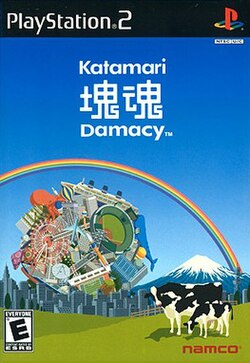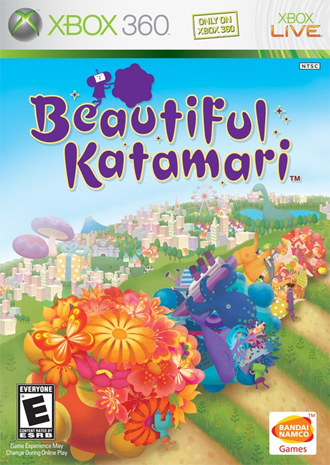A Katamari is the main object of the game. The objective of the game is to roll the Katamari and collect items that miraculously stick to it to “send things to space” to create stars/planets. It is typically a multicolored ball with large dull spikes stiking out of it. It has the ability to pick up anything that is smaller than it and can charge at items with quick speeds and can even jump in newer versions of the game.
The King of all Cosmos is literally the king of the universe. He is basically the catalyst of the whole Katamari story line. As the game play progresses the player gets more familiar with the life of the King and understands his story through vignettes that the player earns by defeating certain levels.
The Prince is one of the main characters. He is the son of the King of all Cosmos who is forced to literally clean up after his father and help repair the cosmos.
The Cousins are other ancillary charcters in the Katamari Franchise. In total, there are 58 playable cousins when all of the different Katamari Franchise games are added together. In the original Katamari Damacy game there are only 24. See below:
Gameplay: While in-game there are several items on the screen that the player needs to pay attention to in order to complete the level successfully. These include the timer and the size indicator (in the upper right and left corner of the screen, respectively). They are indicated on the following image:
Also, the character of which you are playing is shown in the bottom right hand corner of the screen typically indicating what you are doing at that moment. For instance, if you make your character run while pushing the Katamari, the image would portray a rather hardworking prince/cousin pushing while running. Also, the character will change depending on the level/area of the stage you are in. For instance, if you run into the ocean to pick up under-water sea creatures, the character will don a snorkeling mask and flippers. This is just one other way the Katamari franchise is detailed in its efforts to have fun!
Another cute aspect of the screen is the lower left hand object indicator. This indicator tells the player what they just picked up in the Katamari. The game is so detailed that you can literally watch/read every object that you have picked up in the Katamari, these can range from something as small as a pencil to entire buildings and even gods!
Software:
Since Katamari’s first release there have been several sequels. The ones listed below do not include the many mobile versions of the games created for both regular cellular phones and the Iphone/Ipod franchise.
Katamari Damacy
Developer(s): Namco, NOW Production
Publisher: Namco
Designer: Keita Takahashi
Composer: Yū Miyake
Aspect ratio: 480i (SDTV)
Platform: PlayStation 2
Release date(s): March 18, 2004 (Japan), September 22, 2004 (America)
Genre: Third-person puzzle-action
Mode(s): Single-player, multiplayer
Rating(s): CERO: All Ages
KMRB: All Ages
ESRB: E (Everyone)
Media: DVD (1)
Input methods: DualShock
We Love Katamari
 Developer(s): Namco, NOW Production
Developer(s): Namco, NOW Production Publisher(s): Namco, Electronic Arts
Composer(s): Yū Miyake
Aspect ratio: 480i (SDTV)
Platform(s): PlayStation 2
Release date(s): July 6, 2005 (Japan), July 28, 2005 (South Korea), September 20, 2005 (North America), February 2, 2006 (Europe), February 6, 2006 (Australia)
Genre: Third-person puzzle-action
Mode: Single-player, multiplayer
Ratings: CERO: A
ESRB: E
KMRB: All
OFLC: G
PEGI: 3+
Media: DVD-ROM
Input methods: DualShock
Me and My Katamari
Developer(s): Namco, NOW Production
Publisher: Namco
Platform: PlayStation Portable
Release date(s): December 22, 2005 (Japan), March 21, 2006 (North America)
Genre: Third person puzzle-action
Mode(s): Single-player, multiplayer
Rating(s): CERO: A
ESRB: Everyone
OFLC: G
Media: Universal Media Disc
System requirements: Firmware 2.6
Beautiful Katamari
Developer(s): Namco, NOW Production
Publisher: Namco Bandai
Designer: Jun Moriwaki
Aspect ratio: 720p
Platform: Xbox 360
Release date(s): October 16, 2007 (North America), October 18, 2007 (Japan), February 29, 2008 (Europe)
Genre: Third-person puzzle-action
Mode(s): Single player, Multiplayer (2 players offline, 2-4 online)
Rating(s): CERO: A
ESRB: E
OFLC: G (General)
Input methods: Gamepad
Katamari Forever
 Developer: Namco Bandai
Developer: Namco Bandai Publisher: Namco Bandai
Aspect ratio: 1080p (HDTV)
Platform(s): PlayStation 3
Release date(s): July 23, 2009 (Japan), September 18, 2009 (Europe), September 22, 2009 (North America)
Genre: Third person action puzzle
Mode(s): Single-player, multiplayer (offline)
Rating(s): CERO: A (All ages)
ESRB: E (Everyone)
Media: 1 Blu-ray Disc
Input methods: DualShock
Hardware:
Throughout the years Katamari Damacy and its successors have gone on to be developed for multiple platforms. A platform is a type of consol on which the game can be played. The most popular of the consoles the Katamari franchise has appeared on are the Playstation 2, the Playstation 3, the PSP, and the Xbox360.
 The PlayStation 2 (often shortened to PS2) is a sixth-generation video game console manufactured by Sony Computer Entertainment. The successor to the PlayStation, and the predecessor to the PlayStation 3, the PlayStation 2 forms part of the PlayStation series of video game consoles. Its development was announced in March 1999 and it was released a year later in Japan.
The PlayStation 2 (often shortened to PS2) is a sixth-generation video game console manufactured by Sony Computer Entertainment. The successor to the PlayStation, and the predecessor to the PlayStation 3, the PlayStation 2 forms part of the PlayStation series of video game consoles. Its development was announced in March 1999 and it was released a year later in Japan.
The PlayStation 3 (officially abbreviated as PS3) is the third home video game console produced by Sony Computer Entertainment, and the successor to the PlayStation 2 as part of the PlayStation series. The PlayStation 3 competes with Microsoft's Xbox 360 and Nintendo's Wii as part of the seventh generation of video game consoles. The PlayStation 3 was first released on November 11, 2006 in Japan and November 17, 2006 in North America.
The PlayStation Portable (officially abbreviated PSP) is a handheld game console manufactured and marketed by Sony Computer Entertainment. The system was released in Japan on December 12, 2004 and in North America on March 24, 2005. The PlayStation Portable is the first handheld video game console to use an optical disc format, Universal Media Disc (UMD), as its primary storage medium. Other distinguishing features of the console include its large viewing screen, multi-media capabilities, and connectivity with the PlayStation 3, other PSPs, and the Internet.
The Xbox 360 is the second video game console produced by Microsoft, and the successor to the Xbox. The Xbox 360 competes with Sony's PlayStation 3 and Nintendo's Wii as part of the seventh generation of video game consoles. The Xbox 360 was officially unveiled on May 12, 2005. The console sold out completely upon release in all regions except in Japan, and, as of October, 2009, over 34 million units have been sold worldwide.
The DualShock (Trademarked as DUALSHOCK and occasionally referred to as Dual Shock) is a line of vibration-feedback gamepads (remotes) by Sony for the PlayStation, PlayStation 2, and PlayStation 3 video game consoles. The DualShock was introduced in Japan in late 1997, and launched in America in May 1998, meeting with critical success. First introduced as a secondary peripheral for the original PlayStation, a revised PlayStation version came with the controller and subsequently phased out the digital controller that was originally included with the hardware for insert manually, as well as the Sony Dual Analog Controller. The vibration feature on this gamepad is especially helpful in the Katamari Franchise because it gives damage warnings while in gameplay
 The PlayStation 2 (often shortened to PS2) is a sixth-generation video game console manufactured by Sony Computer Entertainment. The successor to the PlayStation, and the predecessor to the PlayStation 3, the PlayStation 2 forms part of the PlayStation series of video game consoles. Its development was announced in March 1999 and it was released a year later in Japan.
The PlayStation 2 (often shortened to PS2) is a sixth-generation video game console manufactured by Sony Computer Entertainment. The successor to the PlayStation, and the predecessor to the PlayStation 3, the PlayStation 2 forms part of the PlayStation series of video game consoles. Its development was announced in March 1999 and it was released a year later in Japan.The PlayStation 3 (officially abbreviated as PS3) is the third home video game console produced by Sony Computer Entertainment, and the successor to the PlayStation 2 as part of the PlayStation series. The PlayStation 3 competes with Microsoft's Xbox 360 and Nintendo's Wii as part of the seventh generation of video game consoles. The PlayStation 3 was first released on November 11, 2006 in Japan and November 17, 2006 in North America.
The PlayStation Portable (officially abbreviated PSP) is a handheld game console manufactured and marketed by Sony Computer Entertainment. The system was released in Japan on December 12, 2004 and in North America on March 24, 2005. The PlayStation Portable is the first handheld video game console to use an optical disc format, Universal Media Disc (UMD), as its primary storage medium. Other distinguishing features of the console include its large viewing screen, multi-media capabilities, and connectivity with the PlayStation 3, other PSPs, and the Internet.
The Xbox 360 is the second video game console produced by Microsoft, and the successor to the Xbox. The Xbox 360 competes with Sony's PlayStation 3 and Nintendo's Wii as part of the seventh generation of video game consoles. The Xbox 360 was officially unveiled on May 12, 2005. The console sold out completely upon release in all regions except in Japan, and, as of October, 2009, over 34 million units have been sold worldwide.
The DualShock (Trademarked as DUALSHOCK and occasionally referred to as Dual Shock) is a line of vibration-feedback gamepads (remotes) by Sony for the PlayStation, PlayStation 2, and PlayStation 3 video game consoles. The DualShock was introduced in Japan in late 1997, and launched in America in May 1998, meeting with critical success. First introduced as a secondary peripheral for the original PlayStation, a revised PlayStation version came with the controller and subsequently phased out the digital controller that was originally included with the hardware for insert manually, as well as the Sony Dual Analog Controller. The vibration feature on this gamepad is especially helpful in the Katamari Franchise because it gives damage warnings while in gameplay
Other Defintions
A video game content rating system is a system used for the classification of video games into suitability-related groups. Most of these systems are associated with and/or sponsored by a government, and are sometimes part of the local motion picture rating system. A few examples of the ones relating to the Katamari franchise are below.
• CERO: Computer Entertainment Rating Organization (Japan)
• KMRB: Korea Media Rating Board (South Korea)
• ESRB: Entertainment Software Rating Board (the U.S.A and Canada)
• CERO: Computer Entertainment Rating Organization (Japan)
• KMRB: Korea Media Rating Board (South Korea)
• ESRB: Entertainment Software Rating Board (the U.S.A and Canada)
Subscribe to:
Comments (Atom)






